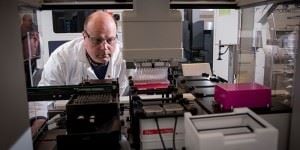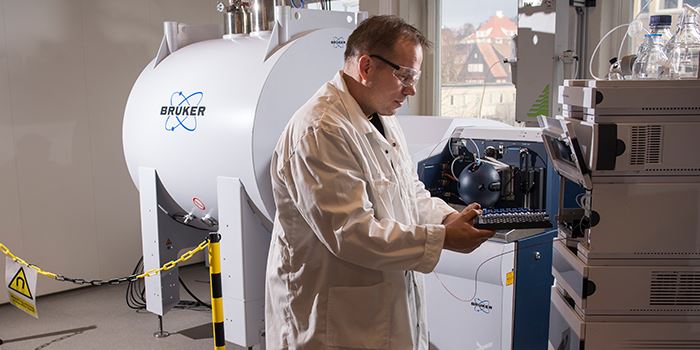Although they are microscopically small, they are the cause of huge problems. Bacteria that have become multiresistant – i.e. resistant to more than one existing type of antibiotic – are regarded as one of the most serious risks to health in the world today.
The latest bad news is that multiresistance is spreading rapidly through the group known as Gram-negative bacteria (see Fact-box). This large family, to which Escherichia coli belongs, includes resistant strains of several microbial species that are capable of producing severe chronic infections. Blood poisoning (sepsis) and the state of shock which may follow sepsis (septic shock), which are caused by such infections, account for some 135,000 deaths in Europe and 215,000 in the USA.
Gram-negative bacteria
Named after the Danish microbiologist Christian Gram (1853–1938). In 1884 he developed a staining method that separates the two main groups of bacteria: Gram-positive and Gram-negative. The Gram-negative group includes resistant strains of the following microbial species:
- Pseudomonas aeruginosa. A common cause of hospital infections, but is found everywhere. It is a major problem for patients with cystic fibrosis, a disease of the lungs.
- Escherichia coli. Normally harmless gut bacteria. However, some strains can cause infections of the gastrointestinal system which may result in small children and elderly people in particular suffering kidney failure.
- Acinetobacter baumannii. A problem for people with a weakened immune system. A frequent cause of hospital infections.
- Klebsiella pneumoniae. Can cause destructive changes in the lung if it is inhaled.
Source: Xellia/SINTEF
“Many lives will be saved if we succeed,” says Grethe Evensen, Principal research scientist at Xellia.
Help from soil bacteria
Antibiotics are chemical compounds that in particular are produced by soil bacteria. In nature, microbes use such chemicals when they are fighting other microorganisms for survival and access to nutrition. A soil bacterium also plays the leading role in the four-year Norwegian-Danish project.
For 70 years, this species has served society by providing us with a wide range of chemical substances known as polymyxins – one of two types of antibiotic that still work on multiresistant bacteria from the Gram-negative family. However, polymyxins have side-effects, in that they affect kidney function, which means that they are far from ideal as a long-term treatment of chronic infections.
The members of the project hope, among other things, that they will be able to develop new antibiotics, with fewer side-effects from these faithful bacteria. They will also be studying what other substances with antibiotic effects they can persuade them to produce.

In this screening laboratory, SINTEF senior scientist Geir Klinkenberg can visualise the ability of the new substances produced by the Norwegian-Danish project to kill resistant bacteria. Photo: SINTEF/Geir Otto Johansen
Click to open
One of the challenges involved concerns triggering the production of new substances in the bacteria, while another centres on characterising these. Xellia is being supported in both of these aspects by SINTEF and Statens Serum Institut.
Efficient and sensitive equipment
In the project, SINTEF uses robotized instruments that allow bacteria to be cultivated under a wide range of conditions, with the aim of provoking the production of new antibiotic substances.
Research Director Håvard Sletta at SINTEF Materials and Chemistry explains that a single instrument set-up is capable of analysing several thousand samples very rapidly, in order to measure the ability of the substances to kill resistant bacteria. SINTEF also has advanced equipment that identifies the unique chemical “fingerprint” of substances that the scientists wish to examine in detail.
“This combination of automated methods and advanced analytical instruments makes our research highly efficient,” says Sletta.
High-risk project
Resistance to antibiotics
- With the rise in the use of antibiotics, pathological microbes have become resistant to more and more types of antibiotics.
- Resistance to antibiotics may be due to small particles of genetic material that can be transferred not only to bacteria of the same species but also to members of wider bacterial groups.
Source: Store norske leksikon
“The Research Council of Norway is contributing the risk-sharing, and that was a decisive factor in our decision to start this project,” says Evensen.
“What do you think are the chances of reaching your goal?”
“As the world’s biggest producer of polymyxins, we have both the experience and capacity needed to develop similar but new antibiotics with fewer side-effects. We have partners who are specialists in fermentation development, advanced analytical methods and pharmaceutical testing, and we ourselves have solid experience in the development of pharmaceuticals. All this means that we have a strong belief that the work we have started will be successful.
Xellia
- Pharmaceutical company with headquarter in Copenhagen.
- The company is a spin-off from the international pharmaceutical company Alpharma, which in turn emerged from the well-known Norwegian pharmaceutical company Apothekernes Laboratorium.
- Was bought up by the Danish company Novo in 2013.
- Focuses on the global market for anti-infection medicines, with sales in more than 70 countries to more than 700 customers.
- Is the world’s leading manufacturer of Vancomycin and CMS (Colistin Methanesulphonate) for the treatment of antibiotic-resistant bacterial infections caused by Gram-positive and Gram-negative bacteria.
Source: Xellia


